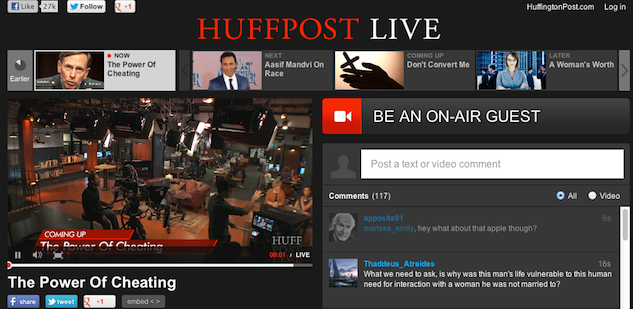
The Huffington Post sees an opening in the growing online video market by melding it with social media, which was a big driver of the Web publisher’s growth.
Janet Balis, the publisher of Huffington Post, said at Digiday’s Video Conference that the company is catering to the “participation generation,” or a group of younger consumers that want to be part of a conversation and are more interested in content where others have voiced their opinions.
The HuffPost Live Network, started in August, brought AOL’s entire video offering under one umbrella that delivers premium content at significant scale within desired audience segments. Recognizing the increasing trend toward multi-screen consumption, all of the videos can be seen across four screens – desktop, tablet, mobile devices and connected TV devices.
“Video consumption continues to grow on all platforms,” Balis said. “That was the first thing that drove us [to launch HuffPost Live.] “The second was a desire for consumers to be part of the conversation.”
By the looks of things on the Huffington Post site, the publisher saw it was breaking conversations and generating real-time consumption and, most important, engagement. Huffington Post recently made it to 200 million comments. It took six years to reach 100 million comments and then another year for the second 100 million. For AOL, this was a signal that times are changing.
That’s when the company decided to build out a studio in New York and Los Angeles for video production for HuffPost Live.
“Video production is something we’ve always been deeply committed to,” Balis said. “The chance to build a new studio and build on that expertise felt quite natural. The building codes in NYC were probably the biggest challenge.”
People are craving a differentiated online experience. HuffPost Live streams 12 hours a day on its own site but also gives people access to all of AOL’s news and all of the most current conversations around it. People who consume the content and engage are really putting themselves out there and taking a story and talking about it from a personal standpoint through Google Hangouts. The integration of Google Hangouts is what Balis calls having “a second screen experience beyond the first screen.”
Balis attributes the success of the platform, which currently reaches 75 million consumers, to the hosts. They are younger, more diverse and they are digital natives. She said they are all experts in their fields. This makes the platform attractive to advertisers, as well.
The advertising on the platform is something different than what the typical publisher now offers. There are no pre-rolls, mid-rolls or post-rolls. The advertising is integrated naturally into the content, so there are no disruptions. Then, of course, there are banner ad opportunities and welcome ads when you first land on the site. Balis said a combination of all three leads to maximum impact.
“We wanted the advertising model to be disruptive,” Balis said. “The Internet is not linear. We do not break for commercials. We want a conversation to end because there’s nothing else to say. That’s why we don’t do any advertising in the stream. Instead, we work on brand integrations in the actual content itself.”
There’s a dedicated team at Huffington Post that works very closely with the customized sponsorships. This ad option is really something of a different beast, and Huffington Post reps are really immersed in the brands they are working with because that’s the only way to ensure that programs are executed well.
The challenge, however, is that every advertiser wants something never done before. But, they want to measure the impact in traditional ways. Some people don’t get that branded content and social content are less about campaigns and more about telling the brand story over time. The HuffPost Live platform lends itself to shape the brand story over time. But not everyone wants to do that.
“It means having a long enough partnership with [Huffington Post,]” Balis said.
More in Media

What publishers are wishing for this holiday season: End AI scraping and determine AI-powered audience value
Publishers want a fair, structured, regulated AI environment and they also want to define what the next decade of audience metrics looks like.

Media giant Essence launches a marketplace for Black women-led brands
Essence has launched WeLoveUs.shop, a new online marketplace dedicated to Black women-led brands.

In Graphic Detail: The state of AI referral traffic in 2025
The stats reveal a new audience pipeline forming outside of traditional search and social platforms.





